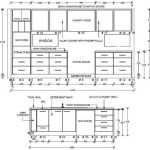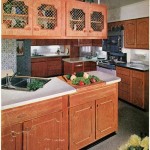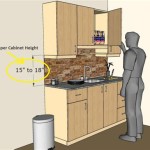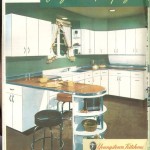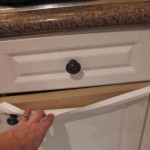Proper Placement of Knobs on Kitchen Cabinets
The placement of knobs on kitchen cabinets is a seemingly minor detail that can significantly impact both the aesthetics and functionality of a kitchen. Correct placement ensures easy accessibility, contributes to a balanced visual appeal, and ultimately enhances the overall user experience. Incorrect placement, conversely, can lead to frustration, awkwardly positioned hardware, and a disharmonious design.
Achieving proper knob placement involves several considerations, including cabinet style, size, and intended use. While there are general guidelines and conventions, the optimal positioning often requires a degree of judgment and adaptation to specific kitchen layouts and personal preferences. Consistency is paramount; once a placement strategy is chosen, it should be uniformly applied across all cabinets to create a cohesive and professional finish.
This article will explore the key principles of knob placement on kitchen cabinets, providing practical guidance and best practices to help homeowners, designers, and installers achieve optimal results. We will delve into the factors influencing placement decisions, offering detailed instructions and visual examples to illustrate the concepts discussed. By understanding these principles, individuals can confidently select and install knobs that not only complement their cabinetry but also enhance the overall functionality and beauty of their kitchen space.
Understanding the Impact of Hardware Choices
Before delving into specific placement instructions, it's crucial to appreciate the broader impact of hardware choices on the overall kitchen design. Knobs, along with pulls and other decorative elements, are not merely functional components; they are integral parts of the kitchen's aesthetic identity. Their style, finish, and placement all contribute to the overall impression of the space.
The selection of knobs should complement the style of the cabinets. For example, sleek, minimalist knobs are often favored in modern kitchens, while more ornate or traditional knobs may be appropriate for classic or farmhouse-style designs. The finish of the knobs should also be carefully considered. Common finishes include brushed nickel, chrome, oil-rubbed bronze, and matte black. The choice of finish should coordinate with other hardware in the kitchen, such as faucets, light fixtures, and appliance handles.
Furthermore, the size and shape of the knobs can influence the perceived scale and proportion of the cabinets. Larger knobs can make a bold statement and are often used on larger cabinets or drawers. Smaller knobs can be more subtle and understated, suitable for smaller cabinets or areas where a less conspicuous look is desired. The shape of the knobs can also add visual interest; round, square, oval, and uniquely shaped knobs are all available to suit different design preferences.
Therefore, before focusing on the precise placement of knobs, it is essential to holistically consider the style, finish, size, and shape of the hardware and how it integrates into the overall kitchen design scheme. This broader perspective will ensure that the selected knobs not only function effectively but also contribute positively to the visual harmony of the space.
Guidelines for Upper Cabinet Knob Placement
The placement of knobs on upper cabinets is governed by slightly different considerations than that of lower cabinets. Because upper cabinets are typically positioned at or above eye level, the visual impact of knob placement is magnified. Furthermore, the accessibility of upper cabinet knobs is critical, as users often reach for them without direct visual confirmation.
A general rule of thumb for upper cabinet knob placement is to position them 2 to 4 inches from the bottom corner of the cabinet door on the side opposite the hinges. This placement is often referred to as the "bottom corner rule." However, the precise distance may need to be adjusted based on the specific design of the cabinet door. For example, if the cabinet door has a raised panel or other decorative feature, the knob should be positioned to avoid interfering with that feature.
For upper cabinets with particularly tall doors, positioning the knob further up from the bottom corner may be necessary to improve accessibility. In such cases, it is recommended to center the knob on the door stile (the vertical frame of the cabinet door). This placement ensures that the knob is within easy reach for users of varying heights.
Another important consideration for upper cabinet knob placement is the symmetry of the overall kitchen design. If the kitchen features a mix of cabinet sizes and styles, it is crucial to maintain visual balance by carefully aligning the knobs across different cabinets. This may involve slightly adjusting the knob placement on individual cabinets to achieve a consistent and harmonious look. Visual confirmation is highly recommended – step back and assess the alignment before permanently installing the knobs.
Special attention should also be paid to corner cabinets. In some cases, a single knob may be sufficient for opening a corner cabinet door. However, for large or heavy corner cabinet doors, two knobs may be preferred to provide additional leverage and stability. If two knobs are used, they should be evenly spaced along the door stile, typically positioned about one-third and two-thirds of the way down from the top of the door.
Finally, it is essential to ensure that the chosen knob placement does not interfere with the operation of adjacent cabinets or appliances. Confirm that the knob does not collide with neighboring doors or drawers when opened. This is particularly important in kitchens with limited space or tight layouts.
Guidelines for Lower Cabinet and Drawer Knob Placement
The placement of knobs on lower cabinets and drawers requires a slightly different approach compared to upper cabinets, primarily due to the lower vantage point and the need to accommodate various drawer configurations. The focus shifts towards ease of access and ergonomic considerations, while also maintaining visual consistency with the upper cabinets.
For lower cabinet doors, the recommended placement is similar to upper cabinets: 2 to 4 inches from the top corner of the door on the side opposite the hinges. This "top corner rule" provides a comfortable reach and maintains a visual alignment with the knobs on the upper cabinets. As with upper cabinets, adjustments may be necessary to avoid any decorative features on the cabinet door.
Drawer knob placement is often more straightforward. For standard drawers, the knob should be centered horizontally on the drawer front. Vertically, the knob should be positioned either in the center of the drawer front or slightly above the center. The choice between these two options often depends on personal preference and the specific design of the drawer. Centering the knob vertically provides a balanced look, while positioning it slightly above center can facilitate easier opening, especially for heavier drawers.
For wider drawers, particularly those used for pots, pans, or other heavy items, using two knobs is often recommended. This provides greater leverage and stability when opening the drawer. In this case, the knobs should be evenly spaced along the drawer front, typically positioned about one-third and two-thirds of the way across from each side. The vertical placement should be consistent with the vertical placement chosen for single-knob drawers.
False-front drawers are common beneath sinks and cooktops. These drawer fronts are often purely decorative and may not require functional knobs. However, installing knobs on these false fronts can enhance the overall visual consistency of the kitchen. In this case, the knobs should be positioned in the same manner as functional drawers, maintaining the same horizontal and vertical placement as the surrounding drawers.
Similar to upper cabinets, it is crucial to verify that the chosen knob placement does not interfere with the operation of adjacent cabinets, appliances, or the user's movement within the kitchen. Pay close attention to clearances and avoid placing knobs in locations that could cause obstructions or pose safety hazards.
When possible, consider installing a temporary knob and testing out the feel and accessibility before drilling permanent holes. This step is particularly valuable when placing knobs on drawers to assess the most comfortable and functional height. Taking the time to test and refine the placement ensures optimal user experience and avoids potentially costly mistakes.

A Simple Guide For Cabinet Knob Placement Julie Blanner

Learn How To Place Kitchen Cabinet Knobs And Pulls Cliqstudios

A Simple Guide For Cabinet Knob Placement Julie Blanner

How To Place Cabinet Knobs Pulls

Cabinet Hardware Placement Guide

Cabinet Hardware Placement Tips Bkc Kitchen And Bath

How To Choose Between Knobs Or Pulls On Kitchen Cabinets

Learn How To Place Kitchen Cabinet Knobs And Pulls Cliqstudios

Cabinet Knob Placement Mog Kitchen Bathroom Remodeling Marietta

A Simple Guide For Ideal Cabinet Knob Placement
Related Posts


